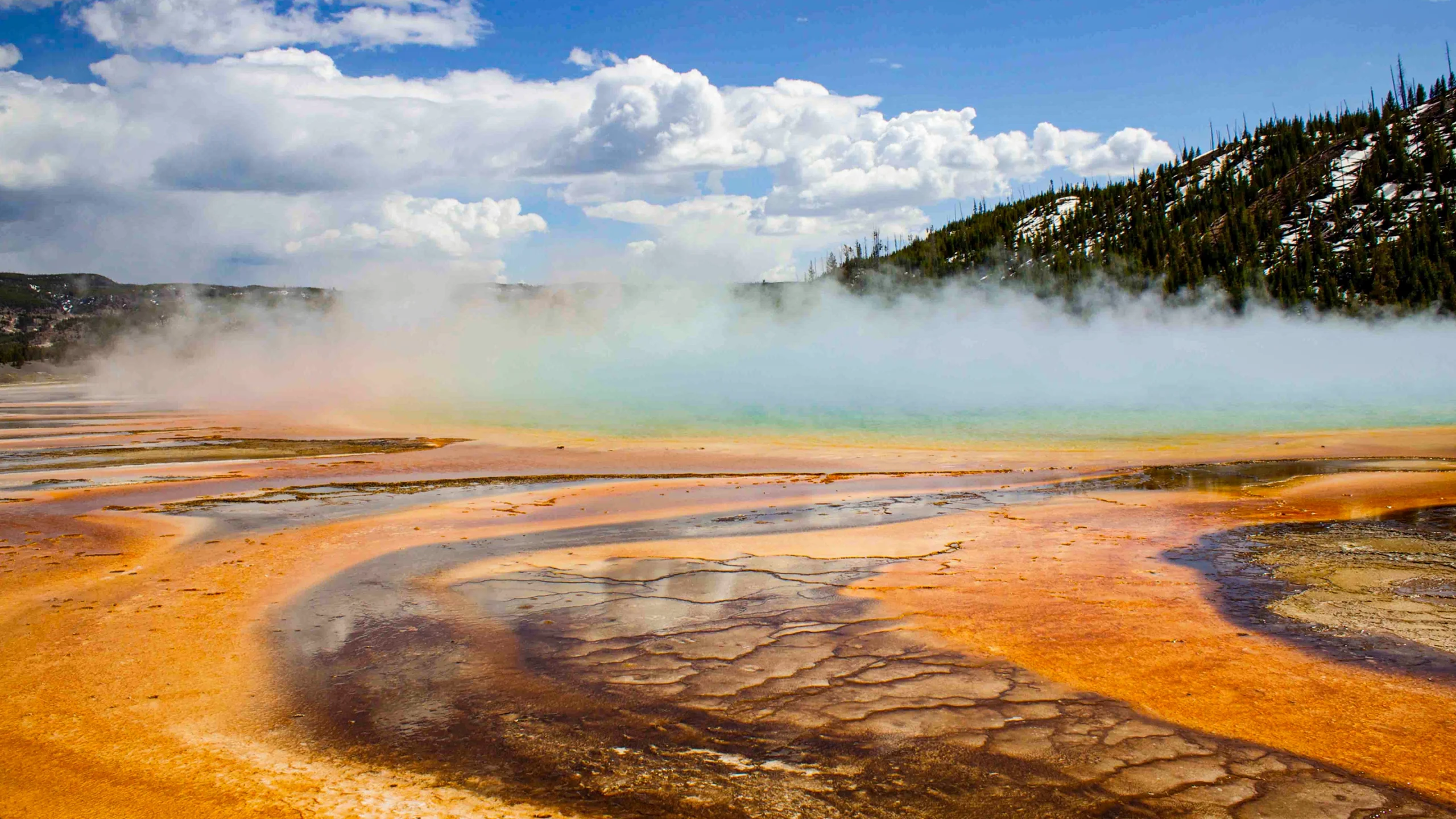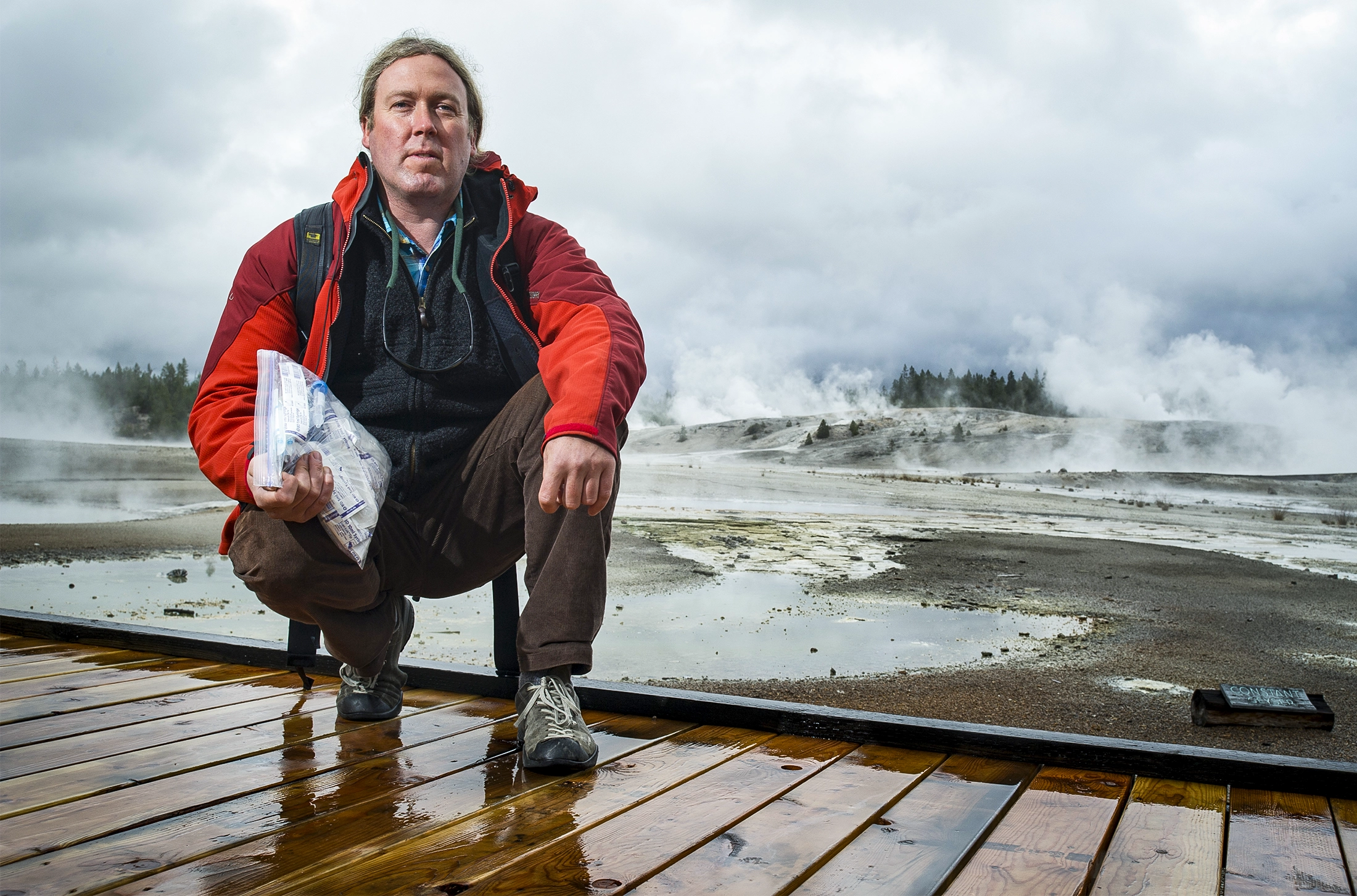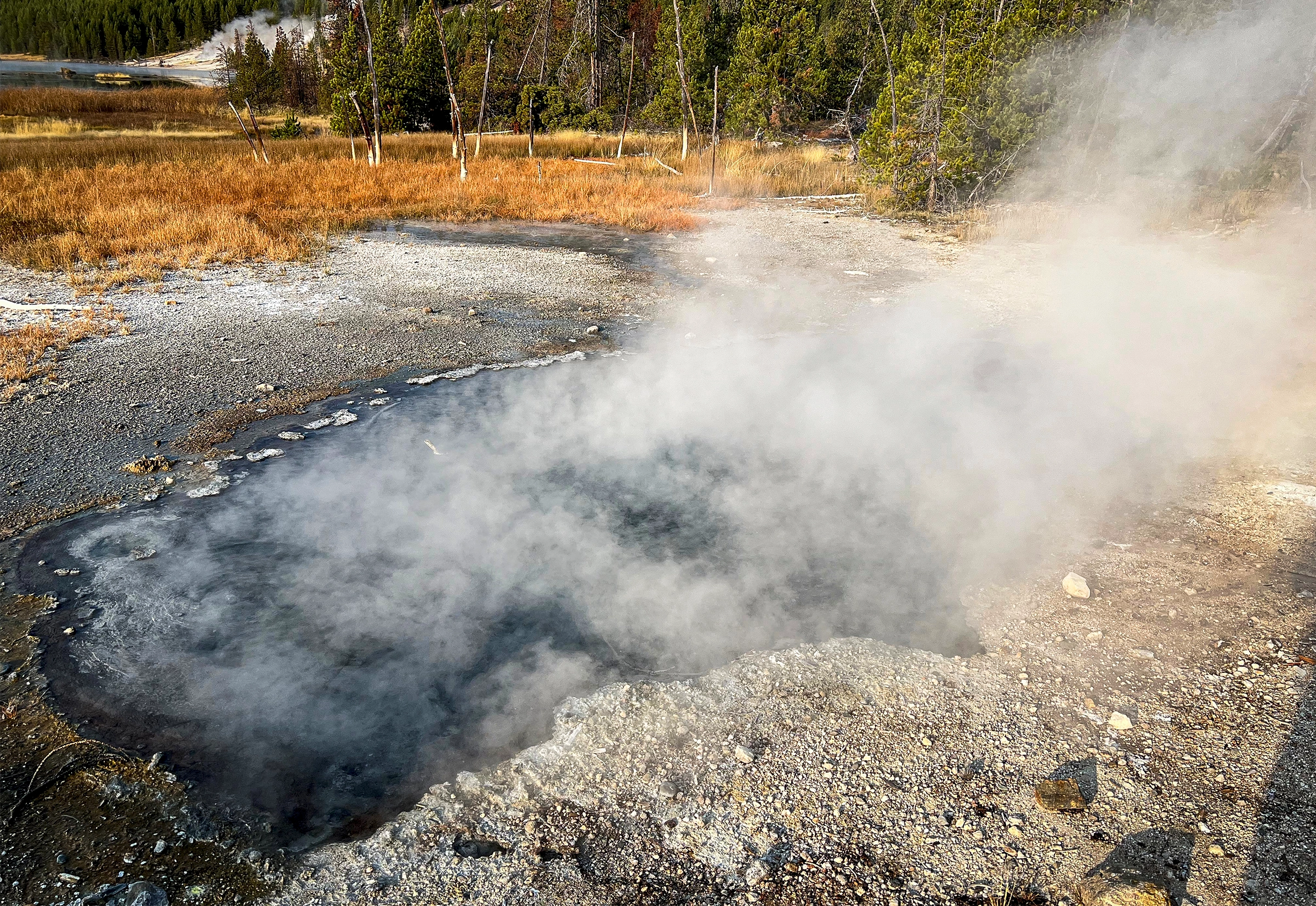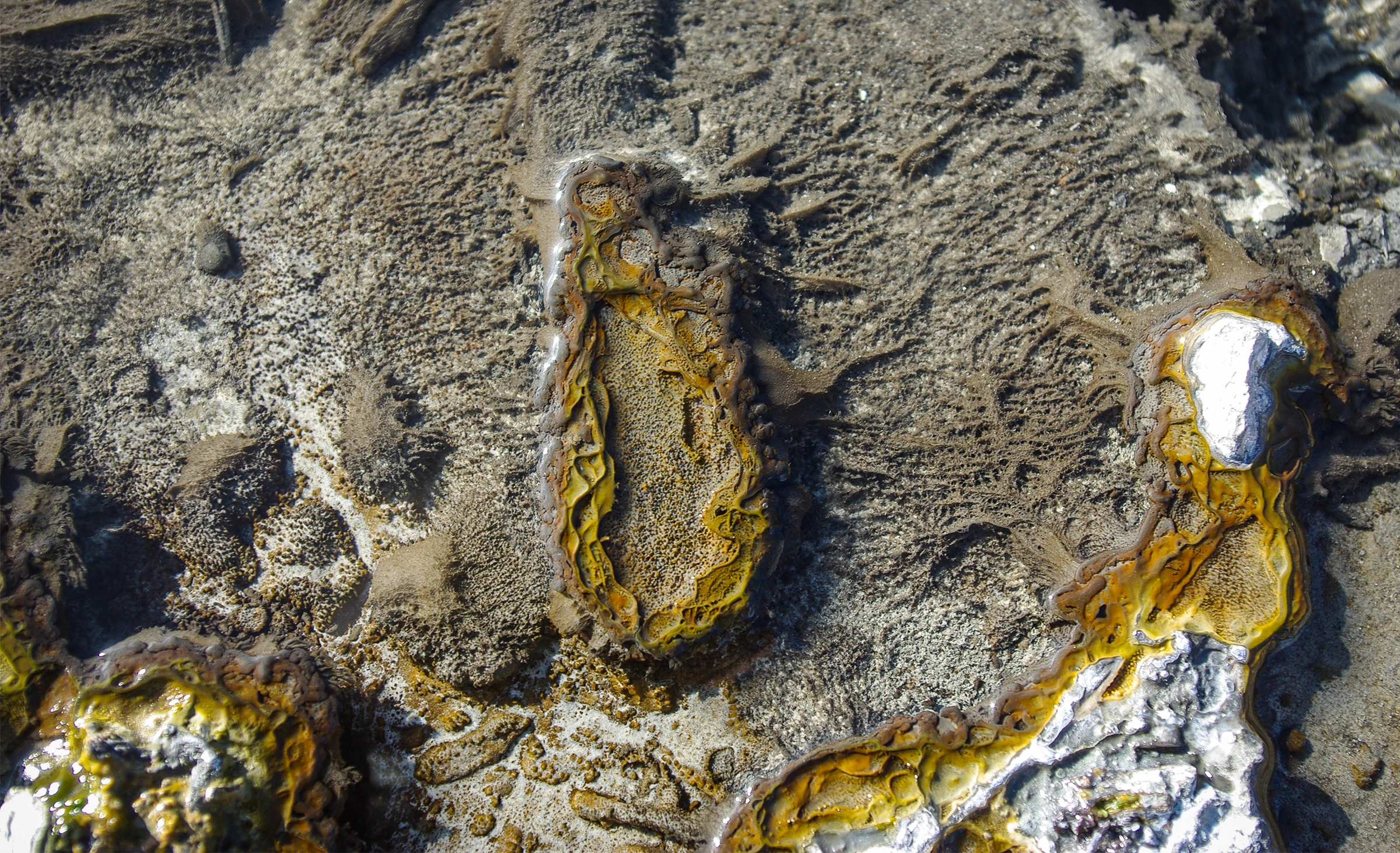The Cells That Breathe Two Ways

Grand Prismatic Spring at Yellowstone National Park has the kind of chaotic chemistry — with both oxygen-rich and oxygen-free areas — that may support dual respiration.
Eric Boyd
Introduction
Take a deep breath. A flow of air has rushed into your lungs, where the oxygen moves into your bloodstream, fueling metabolic fires in cells throughout your body. You, being an aerobic organism, use oxygen as the cellular spark that frees molecular energy from the food you eat. But not all organisms on the planet live or breathe this way. Instead of using oxygen to harvest energy, many single-celled life-forms that live in environments far from oxygen’s reach, such as deep-sea hydrothermal vents or stygian crevices in the soil, wield other elements to respire and unlock energy.
This physical separation of the oxygen-rich and oxygen-free worlds is not merely a matter of life utilizing available resources; it’s a biochemical necessity. Oxygen doesn’t play nice with the metabolic pathways that make it possible to respire with the use of other elements, such as sulfur or manganese. It gives aerobes like us life, but for many anaerobes, or creatures that respire without oxygen, oxygen is a toxin that reacts with and damages their specialized molecular machinery.
“Oxygen — we love it, of course,” said Courtney Stairs, an evolutionary biologist at Lund University in Sweden. “But it’s actually a pretty harmful molecule for most of life on our planet, and even ourselves. We have ways to mitigate the negative effects of oxygen. So we can’t imagine life without it, but life is actually quite hard with it.”
For the first couple billion years of life on Earth, organisms avoided this predicament altogether. Back then, the air and oceans were mostly devoid of oxygen, so life was almost entirely anaerobic, or non-oxygen-breathing. Then, around 2.7 billion years ago, the seas filled with industrious, photosynthetic cyanobacteria. They had invented a way to turn sunlight into sugar and oxygen, and they flourished. Over hundreds of millions of years, their accumulated breathing filled the atmosphere and oceans with oxygen. This so-called Great Oxidation Event was a pivotal transformation in the biosphere and the physical chemistry of Earth’s atmosphere and oceans. In this new environment, aerobic respiration evolved to dominate the world.
An ongoing mystery for researchers is how life navigated the shift from anaerobic to aerobic respiration; so much microbial biodiversity had to adapt to a world filled with what was once a biochemical bane. Now researchers have fresh insight into what that transition could have looked like billions of years ago, gleaned from an organism living today. A bacterium that researchers collected from the cauldron of a Yellowstone National Park hot spring does something that life really shouldn’t be able to do: It runs aerobic and anaerobic metabolisms simultaneously. It breathes oxygen and sulfur at the same time.
The findings “remind us yet again of just how much we still have to learn about microbial diversity and metabolism,” said Natalia Mrnjavac, a graduate student in evolutionary microbiology at Heinrich Heine University Düsseldorf in Germany who was not involved in the study. “And for someone who loves microbes, that is thrilling.”
The findings, which were published earlier this year in Nature Communications, challenge assumptions about the limits of cellular respiration and may give researchers a model for understanding how life walks the edge of paradise and poison.
Metabolic Tricks
It has long been known that life-forms have evolved ways of alternating between aerobic and anaerobic respiration, for instance as a last resort when oxygen levels are low. But because oxygen disrupts anaerobic respiration, many researchers assumed that cells couldn’t grow while using both processes at the same time.
So when Eric Boyd, a microbiologist at Montana State University in Bozeman, and his colleagues uncovered reports from the late 1990s and early 2000s suggesting that some bacteria might be doing just that, their curiosity was piqued. Specifically, bacteria had been observed making sulfide, a product of anaerobic respiration, even when oxygen was present in the environment. “It’s weird to read something like that because it challenges the textbooks — of what you know to be true of microbial metabolism,” he recalled.

Eric Boyd collects microorganisms from hostile environments, such as hot springs, to examine how they manage to survive there.
Kelly Gorham/Montana State University News Service
Boyd is interested in how life evolves and persists in some of the most chemically and thermally hostile places on Earth. He and his team study the mix of hardy microbes living in the seams between the surface and subterranean worlds, including the volcanic vents and thermal pools of Yellowstone National Park, not far from his university in Montana. The strange microbe, which appeared to use anaerobic respiration even when oxygen was available, was right up his alley. To learn more about it, Boyd and his team would have to explore the kinds of turbulent springs such a microbe would prefer, where volcanic bubbles mix with the oxygen-rich atmosphere and oxygen-free underground water.
From a roadside thermal spring near Nymph Lake in the northwest portion of the park, they collected and isolated a strain dubbed Hydrogenobacter RSW1. RSW1 seemed like a natural candidate for a study in unusual respiration. The bacterium is common in volcanically influenced hot springs around the world, from Iceland to New Zealand, and can grow on very limited amounts of oxygen. Plus, it is in the same order, Aquificales, as the curious microbes from the earlier reports. The researchers brought it back to the lab so they could grow it and study its metabolism.
The team members went through a process of incrementally determining what elements and molecules the bacterial strain could grow on. They already knew it could use oxygen, so they tested other combinations in the lab. When oxygen was absent, RSW1 could process hydrogen gas and elemental sulfur — chemicals it would find spewing from a volcanic vent — and create hydrogen sulfide as a product. Yet while the cells were technically alive in this state, they didn’t grow or replicate. They were making a small amount of energy — just enough to stay alive, nothing more. “The cell was just sitting there spinning its wheels without getting any real metabolic or biomass gain out of it,” Boyd said.
Then the team added oxygen back into the mix. As expected, the bacteria grew faster. But, to the researchers’ surprise, RSW1 also still produced hydrogen sulfide gas, as if it were anaerobically respiring. In fact, the bacteria seemed to be breathing both aerobically and anaerobically at once, and benefiting from the energy of both processes. This double respiration went further than the earlier reports: The cell wasn’t just producing sulfide in the presence of oxygen but was also performing both conflicting processes at the same time. Bacteria simply shouldn’t be able to do that.
“That set us down this path of ‘OK, what the heck’s really going on here?’” Boyd said.
Breathing Two Ways
RSW1 appears to have a hybrid metabolism, running an anaerobic sulfur-based mode at the same time it runs an aerobic one using oxygen.
“For an organism to be able to bridge both those metabolisms is very unique,” said Ranjani Murali, an environmental microbiologist at the University of Nevada, Las Vegas, who was not involved in the research. Normally when anaerobic organisms are exposed to oxygen, damaging molecules known as reactive oxygen compounds create stress, she said. “For that not to happen is really interesting.”


In the thermal spring Roadside West (left) in Yellowstone National Park, researchers isolated an unusual microbe from the gray-colored biofilm (right).
Eric Boyd
Boyd’s team observed that the bacteria grew best when running both metabolisms simultaneously. It may be an advantage in its unique environment: Oxygen isn’t evenly distributed in hot springs like those where RSW1 lives. In constantly changing conditions, where you could be bathed in oxygen one moment only for it to disappear, hedging one’s metabolic bets might be a highly adaptive trait.
Other microbes have been observed breathing two ways at once: anaerobically with nitrate and aerobically with oxygen. But those processes use entirely different chemical pathways, and when paired together, they tend to present an energetic cost to the microbes. In contrast, RSW1’s hybrid sulfur/oxygen metabolism bolsters the cells instead of dragging them down.
This kind of dual respiration may have evaded detection until now because it was considered impossible. “You have really no reason to look” for something like this, Boyd said. Additionally, oxygen and sulfide react with each other quickly; unless you were watching for sulfide as a byproduct, you might miss it entirely, he added.
It’s possible, in fact, that microbes with dual metabolisms are widespread, Murali said. She pointed to the many habitats and organisms that exist at tenuous gradients between oxygen-rich and oxygen-free areas. One example is in submerged sediments, which can harbor cable bacteria. These elongated microbes orient themselves in such a way that one end of their bodies can use aerobic respiration in oxygenated water while the other end is buried deep in anoxic sediment and uses anaerobic respiration. Cable bacteria thrive in their precarious partition by physically separating their aerobic and anaerobic processes. But RSW1 appears to multitask while tumbling around in the roiling spring.
It’s still unknown how RSW1 bacteria manage to protect their anaerobic machinery from oxygen. Murali speculated that the cells might create chemical supercomplexes within themselves that can surround, isolate and “scavenge” oxygen, she said — using it up quickly once they encounter it so there is no chance for the gas to interfere with the sulfur-based breathing.
RSW1 and any other microbes that have dual metabolism make intriguing models for how microbial life may have evolved during the Great Oxygenation Event, Boyd said. “That must have been a quite chaotic time for microbes on the planet,” he said. As a slow drip of oxygen filtered into the atmosphere and sea, any life-form that could handle an occasional brush with the new, poisonous gas — or even use it to its energetic benefit — may have been at an advantage. In that time of transition, two metabolisms may have been better than one.



